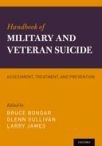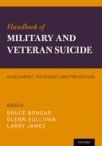Handbook of Military and Veteran Suicide: Assessment, Treatment, and Prevention
Handbook of Military and Veteran Suicide: Assessment, Treatment, and Prevention
Calvin Distinguished Professor of Psychology
Associate Professor of Psychology
Professor
Cite
Abstract
There are approximately 30,000 suicides in the United States each year. Over 20% of these suicides are completed by active duty service members and military veterans. Experts in the field of military suicide collaboratively contributed to this textbook to summarize the current state of research on this important topic. The text encompasses various themes; it defines the scope of the problem, outlines current methods for screening and assessing suicide risk, summarizes both evidence-based treatments and risk management techniques, and describes current suicide prevention efforts. Specific topics among such themes explore the effect of psychological trauma, traumatic brain injury, and the impact of military culture on suicide risk. In addition, the text provides an overview of suicide efforts targeted for special population veteran and active duty service members, such as the Army National Guard and Special Operations Forces. Ethical considerations, challenges of research, as well as future directions are highlighted to provide the reader with a critical analysis of military and veteran suicide research. The information provided herein is ideal for care providers such as physicians, psychologists, and mental health professionals—as well as academics whose work involves military service members and veterans.
-
Front Matter
-
1
Introduction to Military Suicide
Elvin Sheykhani and others
-
2
Why Suicide?
Victoria Kendrick and others
-
3
Suicide and the American Military’s Experience in Iraq and Afghanistan
Joseph Tomlins and others
-
4
Suicide in the Army National Guard: Findings, Interpretations, and Implications for Prevention
James Griffith
-
5
Combat Experience and the Acquired Capability for Suicide
Craig J. Bryan and others
-
6
Combat-Related Killing and the Interpersonal-Psychological Theory of Suicide
Lindsey L. Monteith andShira Maguen
-
7
Suicide Risk Assessment with Combat Veterans—Part I: Contextual Factors
Christopher G. AhnAllen and others
-
8
Suicide Risk Assessment with Combat Veterans—Part II: Assessment and Management
Phillip M. Kleespies and others
-
9
Driving Themselves to Death: Covert and Subintentioned Suicide among Veterans
Glenn Sullivan and others
-
10
Identifying MMPI-2 Risk Factors for Suicide
John J. Barreto andRoger L. Greene
-
11
Ethical Issues in the Treatment of Suicidal Military Personnel and Veterans
W. Brad Johnson andGerald P. Koocher
-
12
Evidence-Based Treatments for PTSD: Clinical Considerations for PTSD and Comorbid Suicidality
Afsoon Eftekhari and others
-
13
The Collaborative Assessment and Management of Suicidality with Suicidal Service Members
David A. Jobes and others
-
14
Healing the Hidden Wounds of War: Treating the Combat Veteran with PTSD at Risk for Suicide
Herbert Hendin
-
15
Understanding Traumatic Brain Injury and Suicide Through the Lens of Executive Dysfunction
Beeta Y. Homaifar and others
-
16
The Problem of Suicide in the United States Special Operations Forces
Bruce Bongar and others
-
17
Managing Suicide in the Older Veteran
Bavna B. Vyas and others
-
18
Person-Centered Suicide Prevention in Primary Care Settings
Paul R. Duberstein and others
-
19
Caring Letters for Military Suicide Prevention
David D. Luxton
-
End Matter
Sign in
Personal account
- Sign in with email/username & password
- Get email alerts
- Save searches
- Purchase content
- Activate your purchase/trial code
Institutional access
-
Sign in through your institution
- Sign in with a library card Sign in with username/password Recommend to your librarian
Institutional account management
Sign in as administratorPurchase
Our books are available by subscription or purchase to libraries and institutions.
Purchasing information| Month: | Total Views: |
|---|---|
| October 2022 | 2 |
| October 2022 | 8 |
| October 2022 | 3 |
| October 2022 | 3 |
| October 2022 | 1 |
| October 2022 | 3 |
| November 2022 | 2 |
| November 2022 | 2 |
| November 2022 | 1 |
| November 2022 | 1 |
| November 2022 | 4 |
| December 2022 | 1 |
| January 2023 | 1 |
| January 2023 | 2 |
| January 2023 | 1 |
| January 2023 | 1 |
| February 2023 | 1 |
| February 2023 | 3 |
| February 2023 | 1 |
| February 2023 | 1 |
| February 2023 | 1 |
| March 2023 | 1 |
| March 2023 | 1 |
| April 2023 | 2 |
| April 2023 | 1 |
| April 2023 | 1 |
| April 2023 | 2 |
| April 2023 | 1 |
| April 2023 | 1 |
| April 2023 | 1 |
| April 2023 | 1 |
| April 2023 | 1 |
| April 2023 | 4 |
| April 2023 | 1 |
| May 2023 | 1 |
| May 2023 | 2 |
| June 2023 | 6 |
| July 2023 | 1 |
| July 2023 | 1 |
| August 2023 | 4 |
| September 2023 | 2 |
| September 2023 | 1 |
| September 2023 | 5 |
| September 2023 | 1 |
| September 2023 | 1 |
| September 2023 | 1 |
| September 2023 | 1 |
| September 2023 | 2 |
| September 2023 | 1 |
| October 2023 | 1 |
| October 2023 | 2 |
| October 2023 | 1 |
| October 2023 | 3 |
| October 2023 | 2 |
| October 2023 | 1 |
| November 2023 | 2 |
| November 2023 | 1 |
| November 2023 | 1 |
| November 2023 | 1 |
| January 2024 | 1 |
| January 2024 | 1 |
| January 2024 | 1 |
| January 2024 | 4 |
| January 2024 | 1 |
| January 2024 | 1 |
| January 2024 | 2 |
| January 2024 | 3 |
| January 2024 | 1 |
| January 2024 | 2 |
| January 2024 | 1 |
| January 2024 | 1 |
| January 2024 | 1 |
| January 2024 | 1 |
| January 2024 | 1 |
| January 2024 | 1 |
| January 2024 | 2 |
| January 2024 | 1 |
| January 2024 | 1 |
| January 2024 | 1 |
| January 2024 | 1 |
| January 2024 | 1 |
| February 2024 | 2 |
| February 2024 | 2 |
| February 2024 | 2 |
| February 2024 | 2 |
| February 2024 | 5 |
| February 2024 | 2 |
| February 2024 | 4 |
| February 2024 | 4 |
| February 2024 | 1 |
| February 2024 | 3 |
| February 2024 | 1 |
| March 2024 | 1 |
| March 2024 | 2 |
| March 2024 | 2 |
| March 2024 | 1 |
| March 2024 | 9 |
| March 2024 | 6 |
| March 2024 | 2 |
| March 2024 | 2 |
| March 2024 | 1 |
| March 2024 | 3 |
| March 2024 | 1 |
| April 2024 | 9 |
| April 2024 | 1 |
| April 2024 | 7 |
| April 2024 | 1 |
| April 2024 | 3 |


Get help with access
Institutional access
Access to content on Oxford Academic is often provided through institutional subscriptions and purchases. If you are a member of an institution with an active account, you may be able to access content in one of the following ways:
IP based access
Typically, access is provided across an institutional network to a range of IP addresses. This authentication occurs automatically, and it is not possible to sign out of an IP authenticated account.
Sign in through your institution
Choose this option to get remote access when outside your institution. Shibboleth/Open Athens technology is used to provide single sign-on between your institution’s website and Oxford Academic.
If your institution is not listed or you cannot sign in to your institution’s website, please contact your librarian or administrator.
Sign in with a library card
Enter your library card number to sign in. If you cannot sign in, please contact your librarian.
Society Members
Society member access to a journal is achieved in one of the following ways:
Sign in through society site
Many societies offer single sign-on between the society website and Oxford Academic. If you see ‘Sign in through society site’ in the sign in pane within a journal:
If you do not have a society account or have forgotten your username or password, please contact your society.
Sign in using a personal account
Some societies use Oxford Academic personal accounts to provide access to their members. See below.
Personal account
A personal account can be used to get email alerts, save searches, purchase content, and activate subscriptions.
Some societies use Oxford Academic personal accounts to provide access to their members.
Viewing your signed in accounts
Click the account icon in the top right to:
Signed in but can't access content
Oxford Academic is home to a wide variety of products. The institutional subscription may not cover the content that you are trying to access. If you believe you should have access to that content, please contact your librarian.
Institutional account management
For librarians and administrators, your personal account also provides access to institutional account management. Here you will find options to view and activate subscriptions, manage institutional settings and access options, access usage statistics, and more.